Hello Xrk!
I have not bought yet the SB65WBAC25 full ranges. I want your opinion on this possible setup: 2way synergy, one SB65WBAC25 at throat and one B&C 12PE32 entering on one lateral side. 100cm wide, 60cm height, 220Hz horizontal pattern control frequency.
Crossover point could be 600hz. I simulated a cosyne horn in Hornresp. The midbass section for 12pe32 looks good, going good to 800hz and then dropping. I wonder: Can the SB65WBAC25 do 97dB for long periods of time? (not that i listen at these levels but who knows what wild party it will endure some day.. 🙂 ) . The 12pe32 is much stronger obviously. No worries there.
I also have a question on how good this SB65WBAC25 can play so many octaves.. Do you like it? Are the highs OK? On paper looks good: Test Bench - SB Acoustics SB65WBAC25-4 2.5? full-range driver
I will buy a pair anyway soon, but until then and until they arrive i thought of asking you this questions.
Thanks!
I have not bought yet the SB65WBAC25 full ranges. I want your opinion on this possible setup: 2way synergy, one SB65WBAC25 at throat and one B&C 12PE32 entering on one lateral side. 100cm wide, 60cm height, 220Hz horizontal pattern control frequency.
Crossover point could be 600hz. I simulated a cosyne horn in Hornresp. The midbass section for 12pe32 looks good, going good to 800hz and then dropping. I wonder: Can the SB65WBAC25 do 97dB for long periods of time? (not that i listen at these levels but who knows what wild party it will endure some day.. 🙂 ) . The 12pe32 is much stronger obviously. No worries there.
I also have a question on how good this SB65WBAC25 can play so many octaves.. Do you like it? Are the highs OK? On paper looks good: Test Bench - SB Acoustics SB65WBAC25-4 2.5? full-range driver
I will buy a pair anyway soon, but until then and until they arrive i thought of asking you this questions.
Thanks!
The SB65WBAC25-5 is a relatively low sensitivity driver. I thinks it's line 82dB or so and even in a horn, there is 10dB gain circa 2kHz to 5kHz but that falls off 10dB at 12kHz and above. So you are back to 82dB sensitivity. To get to 97dB is pushing it too much in my opinion. Maybe Bushmeister can tell you based on experience? But then again, if xo is 600Hz, there is not much cone movement and limit is thermal dissipation. Make sure you don't exceed thermal limits which is circa 30w?
I think this is going to work well with the dual 8 inch woofers. It's almost a perfect match for the little SB65WBAC25. Funny how the WG is such a big equalizer for that tiny driver and two massive 8in woofers.
Here is the predicted max SPL with an 8.0 liter rear chamber for each woofer. I think that works out not too bad. I am using qnty 4 x 65mm injection holes here. We are able to get 112dB at 26v at xmax. Using -12dB/oct BW high pass at 70Hz. The f3 is 82Hz - should be doable for the sub woofer to cross over now.
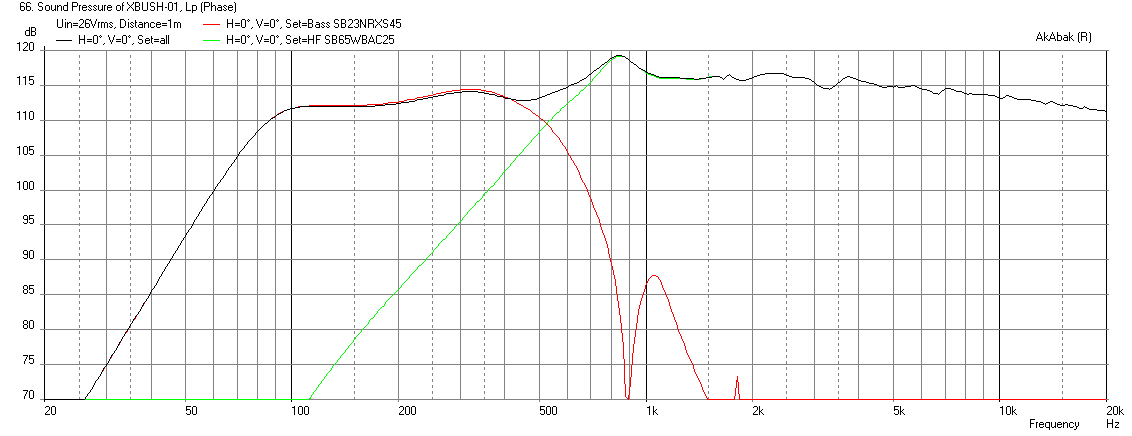
Here is predicted cone displacement:

Here is predicted electrical power input, at max SPL the thermal rating on the little SB65 is being exceeded so can't operate at max continuously. Should be OK for crest factor though.

And for reference, sensitivity at 2.83v is about 93dB:
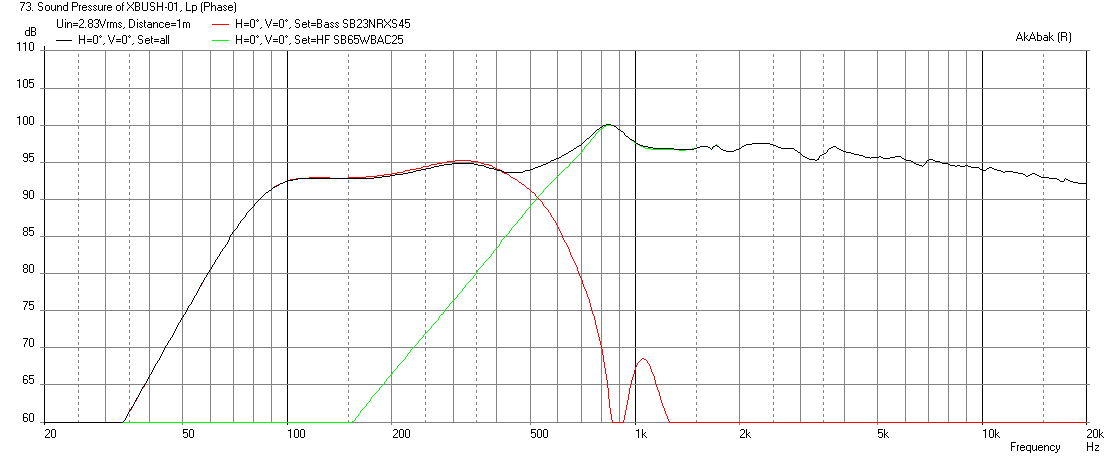
Hi, these are X's sims from early on. As you can see the SB65 can easily hit 120db within it's x-max, but is thermally limited.
It will do 115 at 50w, so peak transients higher are not a problem. It my experience, it will happily go ridiculously loud without issues.
But note these sims are on a specfic horn the 1464, so YMMV.
See my other thread for more measurements, but it will do this all day without issues:
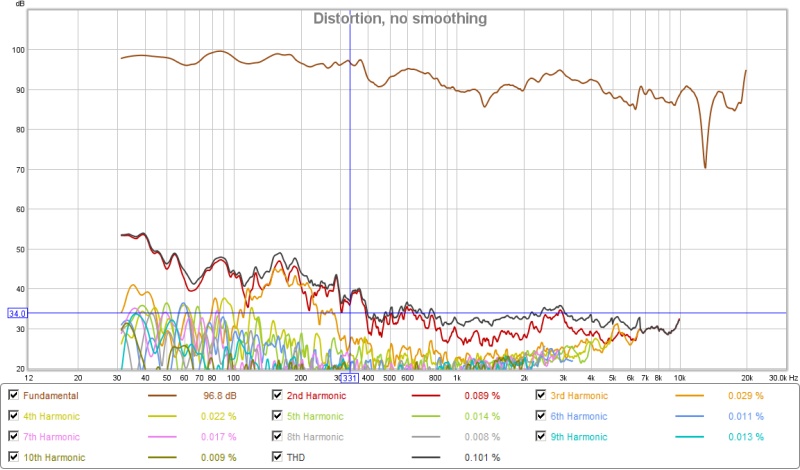
Last edited:
X if you have a moment while you are waiting for parts would you be able to run this 6" SB Acoustics woofer through your akabak sim?
6" SB17MFC35-8 :: SB Acoustics
The SD is half of the 8" but everything else looks good and the poly cone has much less break up that the paper or aluminium.
Fluid,
Here are sims for the 8Sound XT1464 60x50deg waveguide with two SB17MFC35-8 drivers pushing through a 40mm dia x 2 injection holes with a 4 liter rear chamber ea and 100 cc front cone volume assumed. -12dB/oct high pass filter at 85Hz to limit cone excursion. This gives thermal max matching xmax at 20v RMS. Max sustained RMS SPL is about 110dB.
SPL at 2.83v and 1m:
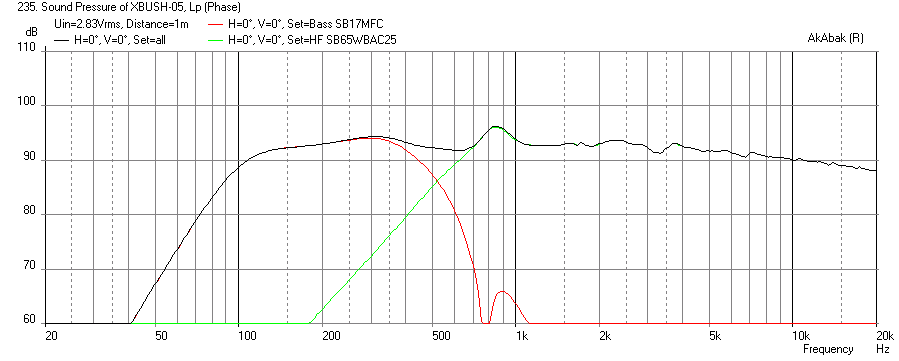
SPL at xmax and themal max at 20v RMS:
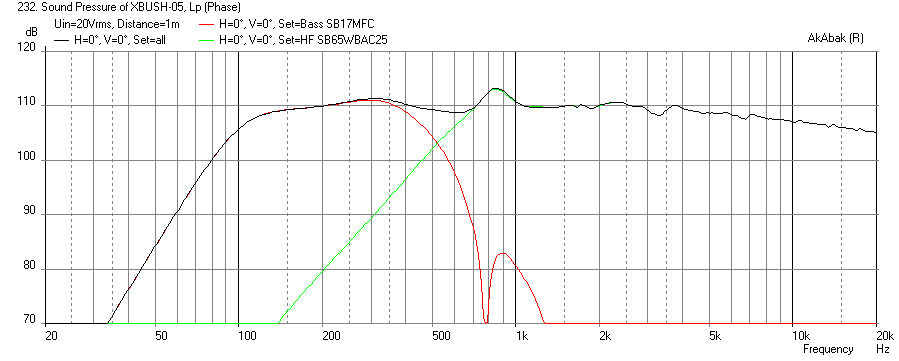
Cone displacement at 20V:
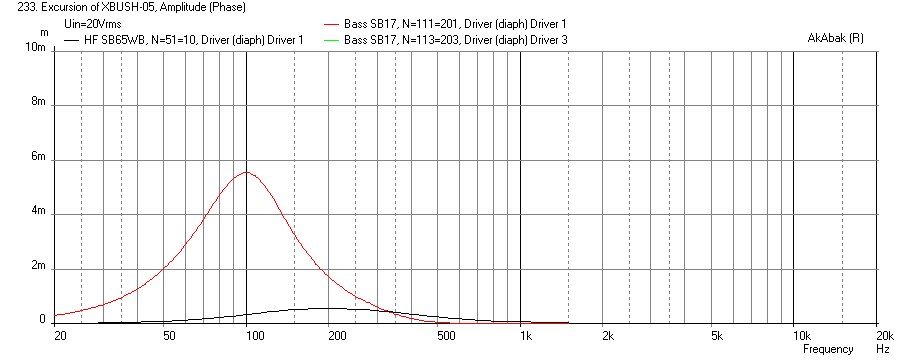
Electrical Power at max SPL:
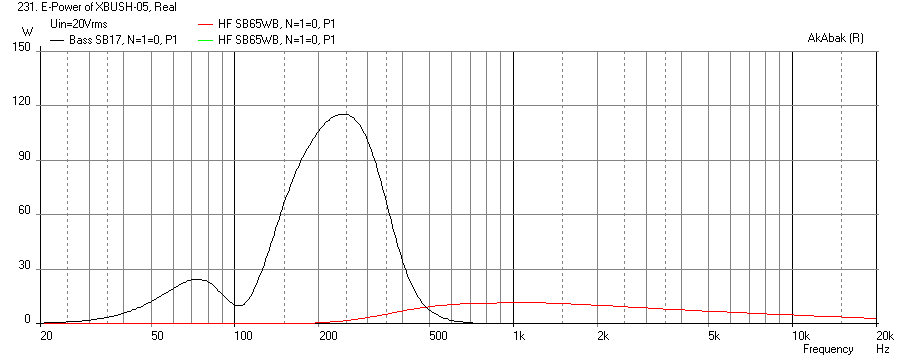
Attachments
Last edited:
X,
Thanks for doing that, much appreciated. Given the fact the enclosure is half the size losing 15Hz extension on the bottom compared to the 8" seems acceptable.
Can I ask at what distance down the horn the ports were?
Also is it 40mm x2 injection holes per driver?
After seeing some of plots of the MFC that were linked to in your monitor thread, it looks to have a pretty horrible distortion profile so I think I would choose the paper cone in this application as the breakup is less of an issue when filtered in the bandpass. The T/S parameters look to be very similar (as only the cone has changed) so the sim should still be valid.
Now I need to get some paper templates out to see where the drivers can be mounted.
Thanks for doing that, much appreciated. Given the fact the enclosure is half the size losing 15Hz extension on the bottom compared to the 8" seems acceptable.
Can I ask at what distance down the horn the ports were?
Also is it 40mm x2 injection holes per driver?
After seeing some of plots of the MFC that were linked to in your monitor thread, it looks to have a pretty horrible distortion profile so I think I would choose the paper cone in this application as the breakup is less of an issue when filtered in the bandpass. The T/S parameters look to be very similar (as only the cone has changed) so the sim should still be valid.
Now I need to get some paper templates out to see where the drivers can be mounted.
Last edited:
Hi Fluid,
You are welcome.
The ports were located 50mm dia (axial distance) from the exit plane of the mouth of the waveguide.
Yes, qnty 2 x 40mm dia ports per driver. If you think you can stuff 4 drivers on this WG, I can sim that too if you want.
Cheers,
X
You are welcome.
Can I ask at what distance down the horn the ports were?
Also is it 40mm x2 injection holes per driver?
The ports were located 50mm dia (axial distance) from the exit plane of the mouth of the waveguide.
Yes, qnty 2 x 40mm dia ports per driver. If you think you can stuff 4 drivers on this WG, I can sim that too if you want.
Cheers,
X
Thanks, to fit 4 on would need to use smaller drivers I think. If I can fit the 6.5in drivers on the sides of the horn then a smaller cabinet similar in shape to the one onni built might be possible.
The difficulty is that is where there is the greatest curvature in the horn and the drivers may not fit properly.
The difficulty is that is where there is the greatest curvature in the horn and the drivers may not fit properly.
So I've been tempted to build this for a while and have been thinking. (Perhaps too much...)
If I was to make a horn to fit a compression driver (for the top end sensitivity) but design the horn to load the mid driver (250 to 400hz flare or thereabouts) which would get mounted "flat" on the horn profile near the throat and use injection ports for the low end - anyone see any obvious issues there? I'm aiming for the mid to cover 500 to 5k or thereabouts, wherever the sensitivity and loading starts to roll off. Probably using TC9FD, possibly 2 per horn? I'm thinking the low end will be the limiting factor, but will have to see what I can get...
Sent from my iPhone using Tapatalk
If I was to make a horn to fit a compression driver (for the top end sensitivity) but design the horn to load the mid driver (250 to 400hz flare or thereabouts) which would get mounted "flat" on the horn profile near the throat and use injection ports for the low end - anyone see any obvious issues there? I'm aiming for the mid to cover 500 to 5k or thereabouts, wherever the sensitivity and loading starts to roll off. Probably using TC9FD, possibly 2 per horn? I'm thinking the low end will be the limiting factor, but will have to see what I can get...
Sent from my iPhone using Tapatalk
The main problem is getting the mid to go smoothly above 1.2kHz. It is a rare Synergy where someone can get the mid bandpass injection to not have a cutoff that happens around 900Hz to 1.3kHz. I think I heard someone say they got it to go to 3.5kHz but that is rare. The problem is the distance from the injection port to the throat of the tweeter. Due to physical limitations, you can never get it close enough and the round trip reflection cancellation kills the mid output above about 1kHz. A compression driver really should be used at 2.5k to 3.5k and above to minimize distortion - just like you suggest. Getting that high of a cutoff is almost impossible if you look at what people are doing in other threads making a synergy with a CD at the throat.
Hence, go with a 1.4in throat or larger and use a small full range for the mid/tweeter. The SB65 is amazingly like an aluminum dome tweeter in that it reaches a true 20kHz before falling off.
Hence, go with a 1.4in throat or larger and use a small full range for the mid/tweeter. The SB65 is amazingly like an aluminum dome tweeter in that it reaches a true 20kHz before falling off.
The problem is due to the diameter, the SB25 is beaming.....read narrowing......at 5khz and above......so all the constant directivity principle are lost on the highest octaves and the device becomes an on axis listening experience...........power response cavitates and that's that.
No free lunch fellas.
No free lunch fellas.
I disagree that a CD needs to be used above 2.5 khz to minimize distortion. There are all kinds of opinions around about how much THD matters in a CD, including Dr. Geddes famous study result that it doesn't, so long as its reasonably low.
Nonetheless, in my Synergy I'm crossing over at 950 Hz to a BMS4550 CD and measured distortion products down 50 db at louder than normal in home listening levels. I should think that would be low enough. Not every 1" exit CD can do that but the BMS can - its minimum recommended XO is 800 Hz.
True, there are a lot more choices for the CD when the XO is at a higher frequency. People have trouble reaching higher frequencies when they use too large (diameter) a driver, use a large driver without a volume plug to minimize air trapped under the cone, or forget to take the acoustic path length inside the CD when calculating or simulating the reflection null. Higher XOs require a narrower horn in order tosatisfy the rule that the distance between mid ports be less than 1/4 wavelength at XO forces.
That is not to say that the solutions built using a 3" full range drivers aren't good ones but one thing they have not been so far is constant directivity solutions.
Nonetheless, in my Synergy I'm crossing over at 950 Hz to a BMS4550 CD and measured distortion products down 50 db at louder than normal in home listening levels. I should think that would be low enough. Not every 1" exit CD can do that but the BMS can - its minimum recommended XO is 800 Hz.
True, there are a lot more choices for the CD when the XO is at a higher frequency. People have trouble reaching higher frequencies when they use too large (diameter) a driver, use a large driver without a volume plug to minimize air trapped under the cone, or forget to take the acoustic path length inside the CD when calculating or simulating the reflection null. Higher XOs require a narrower horn in order tosatisfy the rule that the distance between mid ports be less than 1/4 wavelength at XO forces.
That is not to say that the solutions built using a 3" full range drivers aren't good ones but one thing they have not been so far is constant directivity solutions.
The problem is due to the diameter, the SB25 is beaming.....read narrowing......at 5khz and above......so all the constant directivity principle are lost on the highest octaves and the device becomes an on axis listening experience...........power response cavitates and that's that.
How is the SB65WB25AC beaming above 5kHz? Where is 5kHz "beaming" seen in the polar plots below?

Last edited:
I disagree that a CD needs to be used above 2.5 khz to minimize distortion. There are all kinds of opinions around about how much THD matters in a CD, including Dr. Geddes famous study result that it doesn't, so long as its reasonably low.
Nonetheless, in my Synergy I'm crossing over at 950 Hz to a BMS4550 CD and measured distortion products down 50 db at louder than normal in home listening levels. I should think that would be low enough. Not every 1" exit CD can do that but the BMS can - its minimum recommended XO is 800 Hz.
True, there are a lot more choices for the CD when the XO is at a higher frequency. People have trouble reaching higher frequencies when they use too large (diameter) a driver, use a large driver without a volume plug to minimize air trapped under the cone, or forget to take the acoustic path length inside the CD when calculating or simulating the reflection null. Higher XOs require a narrower horn in order tosatisfy the rule that the distance between mid ports be less than 1/4 wavelength at XO forces.
That is not to say that the solutions built using a 3" full range drivers aren't good ones but one thing they have not been so far is constant directivity solutions.
50dB below is pretty good low HD if you are able to achieve that with a CD. Can you share some plots similar to the xBush so I can get a sense of the HD?

Xrk, i know you had both, the Faital Pro 3FE22 (4, 8, 16ohms) and also the SB65WB25AC.
Which one do you recommend for a 2way synergy, xo at 600Hz, in a conical horn?
Thanks!
Which one do you recommend for a 2way synergy, xo at 600Hz, in a conical horn?
Thanks!
The SB65 is the way to go. In many ways it is a superior driver as mid tweet for a FAST style synergy. It reaches above 20kHz, it doesn't have breakup peaks that plague many other full ranges (probably because dome is rigid aluminum with polymer damping dust cap, and it has a smaller 2.5in form factor perfect for 1.4in throat waveguides. Only downside is relatively low sensitivity - but as it's in a horn - the gain evens things out.
- Home
- Loudspeakers
- Multi-Way
- A Bookshelf Multi-Way Point-Source Horn



